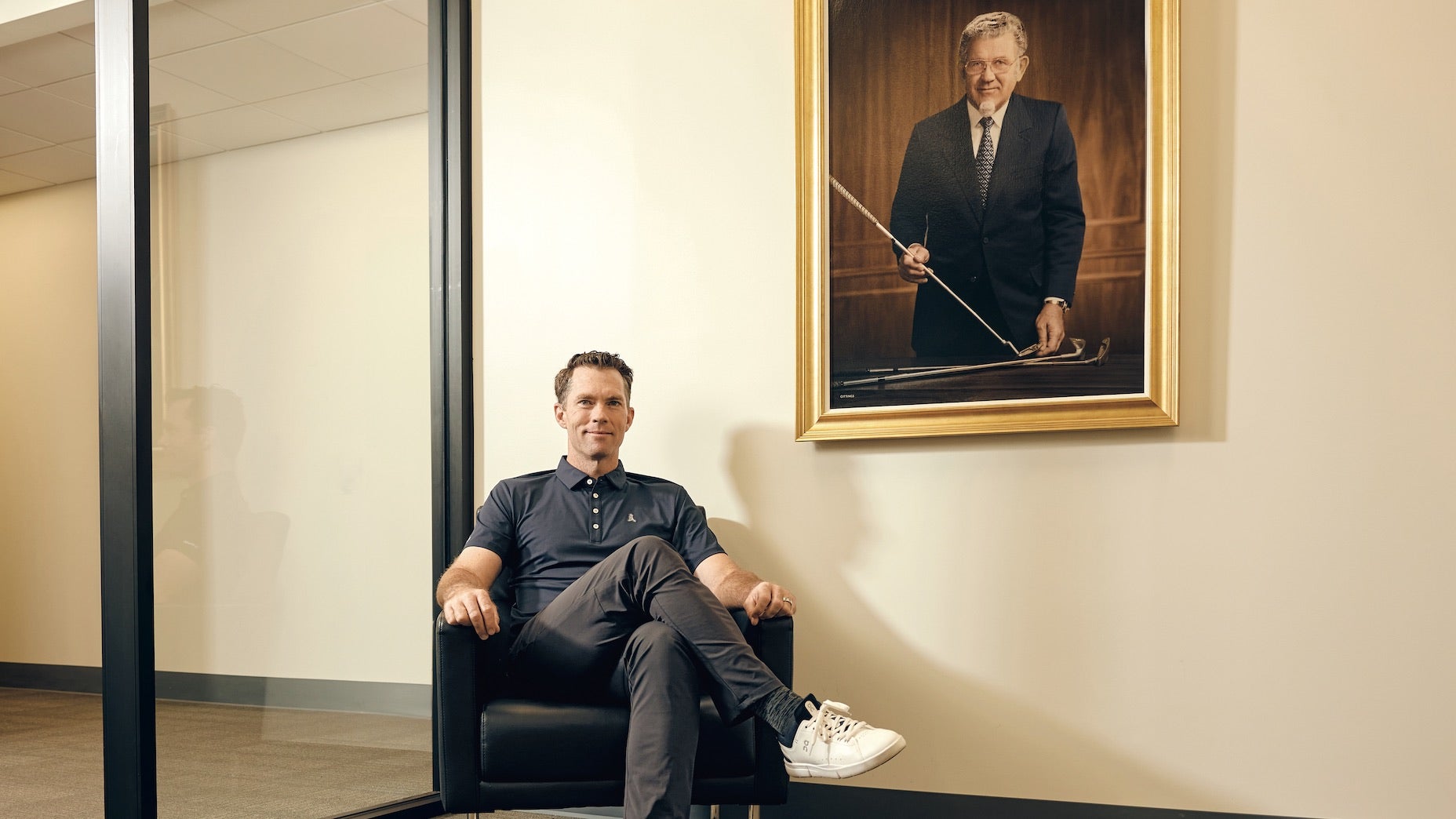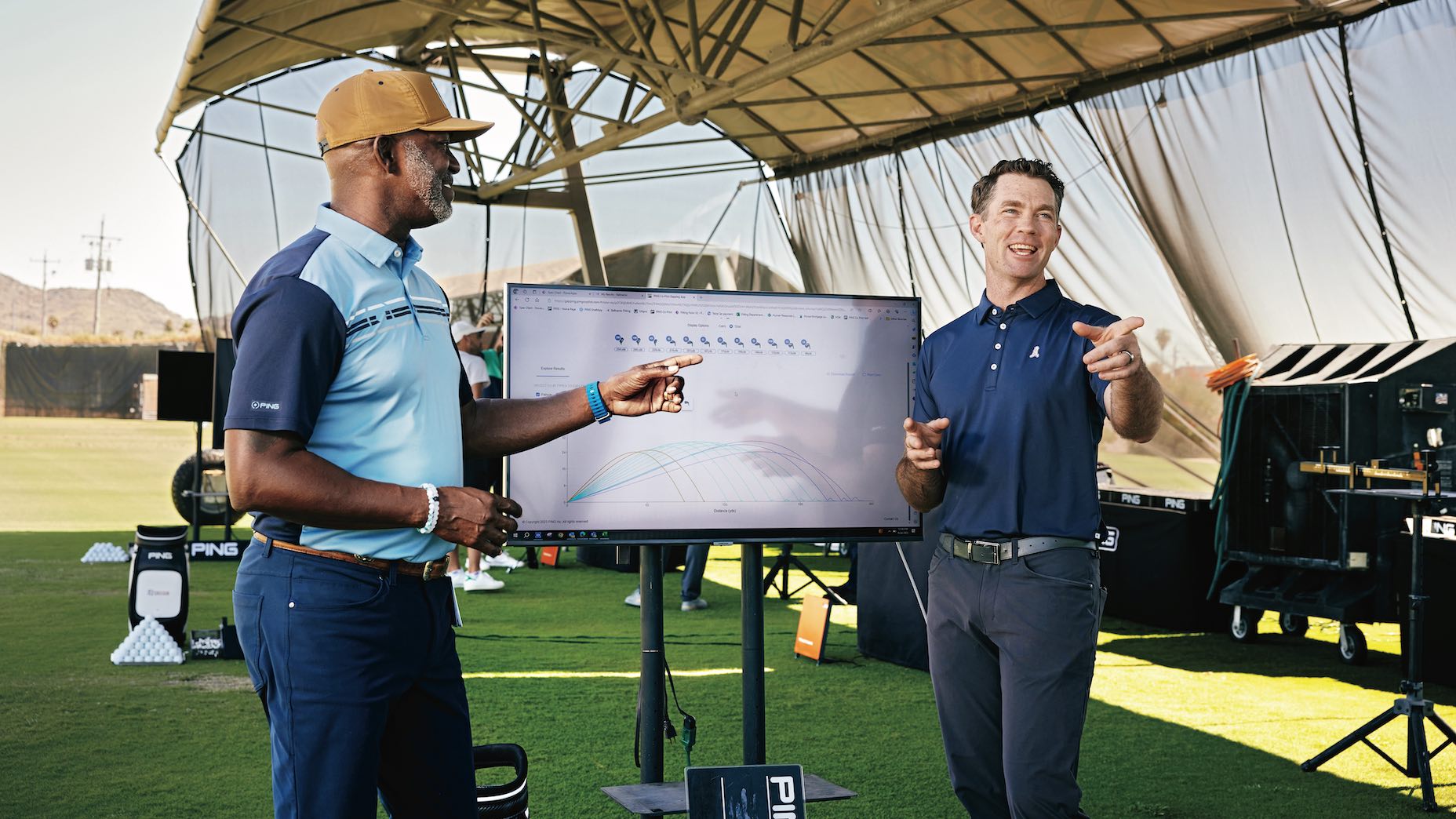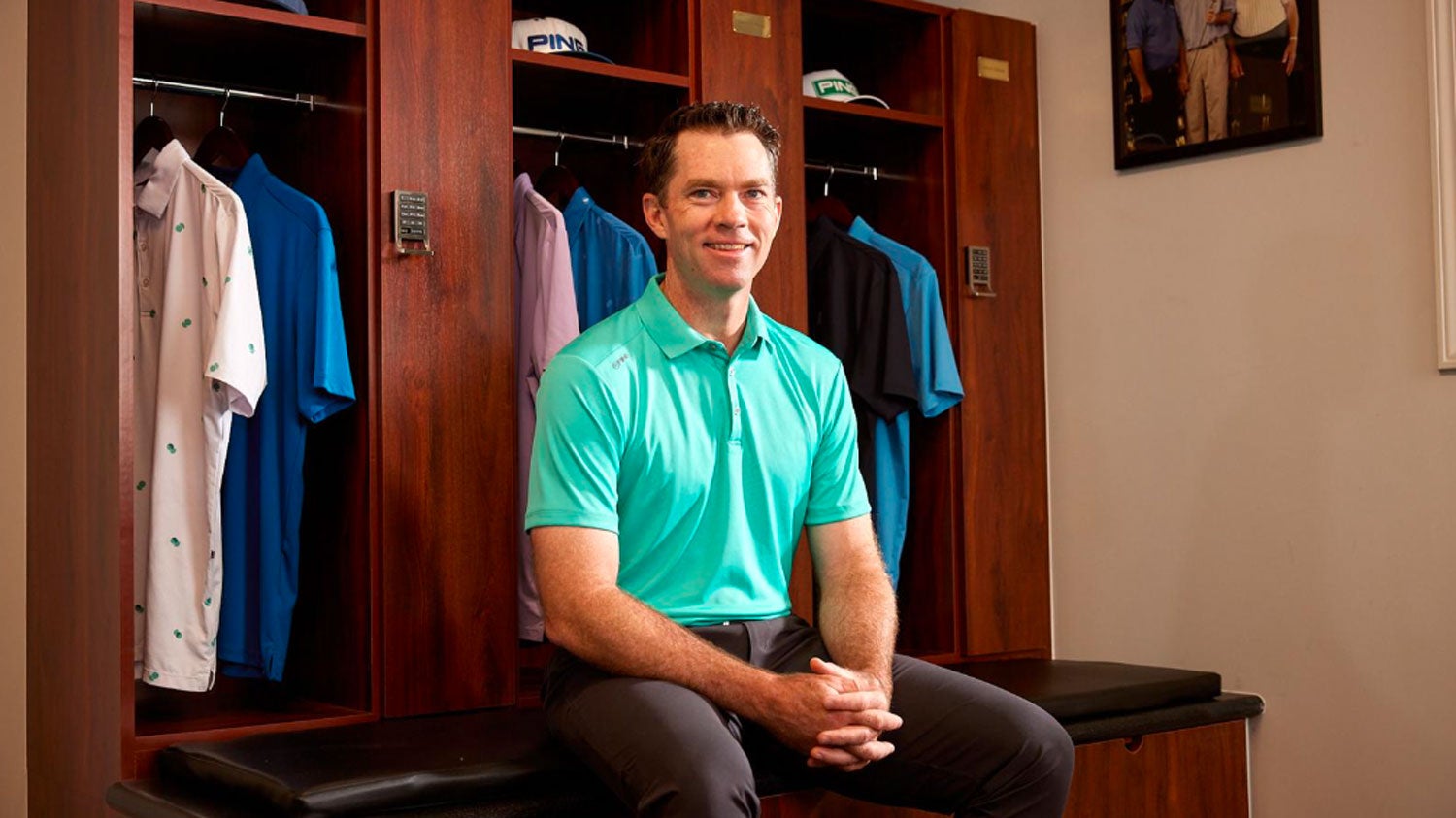
Marty Jertson had a theory he wanted to chase. Before pros started recording clubhead speeds in excess of 140 mph, PING’s current vice president of fitting and performance pondered the upper limits of clubhead speed for a golfer.
How fast could someone swing it?
Through research and observation, Jertson noticed there was a difference between how fast golfers were willing to swing in speed-training sessions, when impacting the ball wasn’t part of the equation, versus a normal cut where they were mentally prepared for a clubface-to-ball collision. Call it a “cognitive governor.”
Armed with a relatively new motion capture system, Jertson went to work 3D-printing a club that required endless amounts of plastic, Bondo self-adhesive, sanding and fashioning of reflective markers in order to bring it to life.
One of Jertson’s colleagues, PING’s director of golf science, Erik Henrikson, recalls that the project took a week to get to the point where the homemade club could launch a small Wiffle ball.
Excited to see if insights could be gleaned from the test, Jertson put the club in motion—and watched as it exploded on impact into more pieces than anyone could count.
“It was a week of work for one shot,” Henrikson recalls. “Marty was snapping the thing together and putting in all this effort—and then it’s done. I think the test, even with the humorous ending, stoked his curiosity even further. Marty’s always been that way. He’s constantly trying to uncover if there’s a different path we should be considering.”
Jertson, 43, willingly admits the initial club was a failure. But the test helped spawn numerous successful speed-training breakthroughs, including the innovative Stack System, which he cocreated a few years ago with biomechanist Dr. Sasho MacKenzie. It powered Matthew Fitzpatrick to his win at the 2022 U.S. Open.
“I think that’s all we do: fail and learn,” Jertson says, during a brief moment of respite in between meetings at PING’s Phoenix headquarters. “For a lot of successful people, failure can be a catalyst for great ideas. Failure generally opens the door to five or 10 more questions you don’t know the answer to, which keeps you curious and engaged.”
For Jertson, failure has indeed opened doors and taken his career in the industry and golf game to new heights. But it didn’t happen overnight.
Prior to joining PING in 2003, Jertson was a promising All-American at the Colorado School of Mines, a kid who was a standard-bearer at the Phoenix Open as a youngster and who aspired to play professional golf for a living. A career in golf club development wasn’t even on his radar.
The research university, he says, “was big in oil and gas exploration. I figured I’d do that, automotive or aerospace with my engineering degree. But first, I really wanted to see if I could make it on tour.”

Matt Martian Williams
Jertson spent 2002, his first year out of college, plying his trade on mini-tours, trying to scratch together enough coin to support himself. But nothing seemed to click. The more pressure he heaped on himself, the more things didn’t go his way. It officially came to a head later in the year, when he missed the first stage of PGA Tour Q-School.
“All the prep, and you get through Q-School or you don’t,” he says. “It’s a binary thing—and it’s still kinda like that. Once Q-School was over, I remember driving back home, trying to make some life decisions.”
Though Jertson didn’t realize it at the time, the Q-School setback was a blessing in disguise. While he contemplated his next move, a mini-tour friend connected him with an acquaintance at PING, and his life trajectory immediately changed.
Jertson came on as a part-time employee, initially in the manufacturing and engineering department, and worked on setting up the assembly line for each part of the G2 driver, a job that eventually set him on a path to club design.
“I’m a golf junkie like everybody else out there,” he says, “and for the first time I remember thinking I could marry those two things together: my engineering degree and my addiction to golf. I think the lesson is that there’s luck along the way, and I probably got lucky just meeting the right people at the right time—and getting in the door at PING.”
****
Take a peek at the clubs in your golf bag and you’ll notice there’s no mention of the designers who brought them to life, which is a shame. Club designers remain the unsung heroes in the equipment space, a coterie of brilliant minds who somehow find a means to turn cutting-edge concepts into game-changing creations for pros and amateurs alike.
Over the last two decades at PING, Jertson, with childlike curiosity and a never-ending drive to innovate, has become one of the most influential and respected designers in the industry. His résumé includes more than 125 patents and countless club designs, including the original “turbulators” (an aerodynamic-enhancing feature on the crown) introduced on the company’s G30 driver and PING’s first foray into the world of adjustable drivers with Anser.
TheStack Swing Speed Trainer (Hardware + App Bundle)
$314 (was $349)
TheStack Hardware
5 milled Stack weights enable 30 weight combinations between 0g and 300g
Dual-purpose weight case / phone stand
Highly engineered training club – Adult (41.5″) or Junior (38.5″) version (see Fitting Juniors)
Speed radar not included. View all compatible devices here. We recommend the PRGR
TheStack App Training
2-year License included, accessible on iOS only.
Dynamic speed training formulated by Dr. Sasho MacKenzie
Guided workout timer for reps, sets, and rest intervals
Custom speed metrics to track your gains
Hands-free data entry using voice entry technology
Includes access to Stack Putting (Beta) – Learn more
Includes Single User License – Enables training and tracking for up to five local (i.e. family) users under one login.
Multi-user Coaches License license sold separately.
Access TheStack App from the App Store when your order arrives. Requires iOS 15.0 or later.
View Product
There’s no question Jertson eats, sleeps and breathes club design. Still, it doesn’t define him. The self-described “bio-hacker” constantly seeks new ways to improve his health and well-being, with the help of an ultra-strict routine that fuels him through the workday. With pockets of free time at a premium, Jertson starts each day in his Phoenix home with a walk on a treadmill desk so he can catch up on email and breeze through administrative tasks before his two sons awaken and throw his morning into a state of flux.
There’s no time for breakfast, just a cup of coffee. Lunch has been the same thing for the last 10 years: a “massive salad” loaded with hard-boiled eggs, onions, bell peppers and broccoli sprouts he usually consumes between meetings. Predictability keeps him sane.
“But even with these efficiencies in place,” Jertson says, “I sometimes finish the day and it’s like, Holy moly, what just happened? I’ll go into one meeting and have a creative session about some far-out ideas, and then the next session is very tactical about the tools we’re doing with our fitters. A lot of times, I’m toggling back and forth. I’ve had to train that skill to compartmentalize, to be very focused wherever I am.”
The hyper-focus is a necessity for a guy who, these days, wears myriad hats at PING. It’s also made it easier for Jertson to find time to keep his game sharp on the course as a “semi-retired” Class A PGA professional who continues to get better—and longer off the tee. With the help of the Stack System he helped create, Jertson has qualified for five PGA Championships, the 2020 U.S. Open and numerous PGA Tour events. That’s in addition to the Southwest PGA events he’s won along the way.
What makes his success on the course so fascinating is how he sometimes uses the tournaments as a proving ground for theories he’s working on in the office. The latest example came this year, during U.S. Open local qualifying, when Jertson was informed that the “one-ball rule” was not in effect. (The rule requires golfers to play the same ball model during competition.)
“I did a triple take,” he recalls. “I’ve always wanted to switch balls during the round, so my brain just started going crazy. There’s definitely a reason to switch balls on different holes.”
Using the work he’s done on Ballnamic, PING’s web-based ball-fitting algorithm, Jertson was able to confirm that certain balls flew five to seven yards farther than other models—and that was just hitting irons.
“In the testing we’ve done, some balls go a little farther and others a little shorter on iron strikes, which could be used to your advantage on par 3s,” he says. “One of the challenges for me as a working player is that I’m not good at the tweener yardages.”
To see if the idea had merit, Jertson played a tournament with different balls designed to provide performance benefits in specific conditions. He played a ball that flew aerodynamically lower and went less offline into the wind and another that launched higher and spun more on downwind shots.
He also assumed, based on the course setup, that he’d be closer to the green with his approaches, so he added a third ball that spun more on wedge shots. If you’re keeping track at home, that’s three different balls for one tournament. Jertson wound up winning the event and is now considering putting into play as many as five different balls, depending on the course and conditions.
Even with Jertson’s impressive track record on the golf course, practice sessions don’t happen nearly as often as he would like. Blame that on the expansion of his role at PING, which now extends well beyond golf club design into the arenas of Artificial Intelligence, data, coding and widgets.
These days, Jertson is not only trying to make PING’s clubs better, he’s also trying, through the PING Academy, to keep the company’s extensive network of fitters up to date on the latest PING research and insights. There’s also iPING, an advanced algorithm designed to guide putter fittings; a new fitter tool called AFS 3D that’s simplifying the club-testing process; and a partnership with Arccos where data findings from amateur golfers are used to shape future product development.

Matt Martian Williams
Jertson oversees one other arrow in PING’s quiver. Called Co-Pilot, it has the potential to completely change the way the equipment manufacturer conducts fittings. Powered by a platform similar to Ballnamic, the fitting tool set spits out suggestions on everything from set composition, club suggestions and adjustments that can be made to squeeze every last ounce of distance out of a PING driver. Co-Pilot has also been used to help pros adjust their setup for PGA Tour events at higher elevations, where changes are likely needed.
Yes, Jertson’s list of responsibilities is extensive. Yet somehow he’s found time to take on more forward-facing duties as the cohost of PING’s Proving Grounds podcast and to mentor several PING engineers along the way. Mentoring is a role Jertson has embraced during his two decades with the company, and a new crop of designers has flourished under his tutelage.
“This team of engineers and designers is special,” he says. “Cory Bacon, Travis Milleman, Ryan Stokke—the list of names could go on and on. I’ve felt lucky to work with them under our apprenticeship model. I almost feel like the students have surpassed their teacher.”
It’s high praise from Jertson, but in PING HQ the admiration is mutual. Bacon, who recently took the lead on his first driver project (the G430), played golf at Colorado School of Mines and in 2011 was offered an internship at PING that turned into a job one year later. He’s blazed his own trail during his 10-plus years with the company, but he freely admits Jertson played a crucial role in his development.
“He’s the one who has mentored me through my entire career here,” Bacon says. “He helped me get my internship, suggested that they hire me when I graduated and basically tutored me for the first four years. I owe a lot to Marty. Having the ability to lean on him, to ask about how he did things when he was in my role, helped a ton throughout the development of the G430. He’s always willing to lend a hand, which I greatly appreciate.”
Jertson might not be a household name like PING staffers Viktor Hovland or Tony Finau, but he’s just as important—if not more so—to the future of PING Golf. With “Mr. Everything” at the helm, the equipment manufacturer is well positioned to do big things in the future.
Now if only Jertson could find time to get in a few more range sessions.









